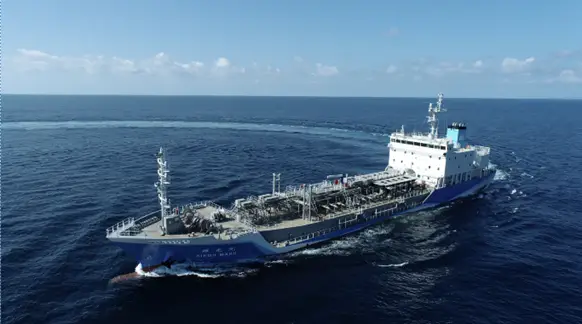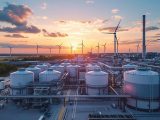
Hydrogen-ready Oil Tanker Kikou Mariner: A Game-Changer for Zero-Emission Shipping
October 28, 2025You can almost feel the energy the moment you stroll into the shipyards of Nagasaki Prefecture. Uyeno Transtech Ltd. has proudly launched the Kikou Maru, a 5,000 KL oil tanker built as a Hydrogen-ready Oil Tanker and driven by whisper-quiet electric motors. With maritime shipping chalked up for about 3% of global CO₂ emissions, ships like the Kikou Maru aren’t just eye candy—they’re a lifeline. This vessel isn’t your run-of-the-mill tanker; it’s a genuine game-changer in Zero-Emission Shipping and a peek at where the industry is headed. Thanks to government-backed financing and a top-tier “S” rating from ClassNK, the Kikou Maru is charting a course toward real Maritime Decarbonization, showing that bold environmental action and maritime tradition can sail hand in hand.
Global Pressures and Japan’s Green Push
The International Maritime Organization has its sights set on slashing shipping emissions 50% by 2050 versus 2008 levels—a tall order. Japan, meanwhile, has vowed to hit net-zero greenhouse gas emissions by 2050, and the shipping sector is a linchpin in that plan. Enter the Kikou Maru: a statement that Japan isn’t waiting around. By rolling out hydrogen propulsion on a coastal tanker under a national green finance scheme, this project stakes its claim as a first-of-its-kind effort. It’s a bold declaration that established maritime nations can blend time-honored expertise with cutting-edge innovation to smash global climate targets.
Nagasaki at the Forefront of Maritime Innovation
Home to over 1.3 million residents, Nagasaki Prefecture has been reinventing shipbuilding since the late 19th century. Today, Fukuoka Shipbuilding Co., Ltd. out on the Nagasaki Yard keeps that spirit alive. Their engineers and welders crafted the Kikou Maru hull for minimal resistance, then future-proofed it with reinforced compartments and piping ready for hydrogen tanks. It’s a masterclass in marrying traditional craftsmanship with forward-looking design, proving that storied shipbuilding hubs can thrive in a low-carbon era and set the benchmark for energy transition.
A Collaboration Driving Decarbonization
Tackling global shipping emissions isn’t a one-hand job. Uyeno Transtech joined forces with the Development Bank of Japan (DBJ) and ClassNK through the Zero-Emission Accelerating Ship Finance Program. DBJ, a wholly government-owned bank since 1951, is pumping green financing into next-gen vessels. ClassNK—a century-old classification society—cooked up the stringent criteria that earned the Kikou Maru its “S” rating. On top of that, the Nippon Foundation has pledged to host the tanker’s hydrogen demo voyage in 2026 under its Zero Emission Ships initiative. This mash-up of public bodies, private industry, and philanthropy shows how pooling vision and resources can fast-track clean tech.
Tech Specs: Batteries and Hydrogen-Readiness
At its heart, the Kikou Maru leans on two key technologies: beefy lithium-ion batteries and a Hydrogen Propulsion system that’s ready to go. Right now, battery power handles coastal legs, slashing fuel use and emissions. Those batteries feed efficient electric motors, cutting reliance on bunker fuel. Meanwhile, the ship’s pre-positioned piping and reinforced tanks mean a swift retrofit for hydrogen bunkering when the infrastructure’s in place. In short, you get immediate emission cuts today and a smooth upgrade path to near-zero tomorrow.
Looking Ahead: 2026 Hydrogen Voyage and Beyond
All eyes will be on the Kikou Maru when it embarks on its hydrogen-powered demo voyage in 2026, courtesy of the Nippon Foundation. By running on pure hydrogen, the ship aims to prove that large-scale cargo transport can operate with minimal greenhouse-gas output. A successful run could light a fire under investments in hydrogen bunkering at ports like Nagasaki, Yokohama, Kobe, and beyond, and push regulators worldwide to craft policies favoring low- and zero-emission ships. Soon enough, shipowners across the globe might be racing to order their own Hydrogen-ready Oil Tanker, propelling the maritime world toward decarbonization faster than ever.
During that voyage, a suite of sensors and telemetry—managed by partners at top maritime institutes—will log everything from fuel consumption and battery cycle efficiency to hydrogen storage integrity. Those real-world insights will feed into the next wave of ship designs and bunkering standards, turbocharging wider adoption.
Standing on the Shoulders of Prior Innovation
Small-scale hydrogen propulsion trials have popped up in Europe and Scandinavia on research vessels and ferries over the past five years. But the Kikou Maru is the first coastal oil tanker built hydrogen-ready under a nationally backed green finance scheme. By scaling up proven tech—electric motors, fuel cells, storage solutions—in a 5,000 KL hull, it bridges the gap between niche demos and commercial reality. It shows that if you’ve got the right financing, classification standards, and industry partnerships in place, even big cargo ships can make the leap.
A Brighter Horizon for Maritime Shipping
Of course, challenges remain. Building out a hydrogen supply and bunkering network takes time, capital, and coordination, and upfront costs for hybrid systems are steeper than conventional designs. But by validating the technology and de-risking investment with government-backed loans, Uyeno Transtech and its allies have charted a promising course for Maritime Decarbonization. This effort dovetails with Japan’s wider net-zero strategy—think carbon capture on vessels and next-gen fuels like ammonia—and offers a blueprint for other maritime hubs, from Rotterdam to Singapore. When you cut emissions, create green jobs, and spark global collaboration, it’s clear: the Kikou Maru isn’t just a tanker. It’s a beacon guiding the industry toward a truly sustainable, zero-emission horizon.


 With over 15 years of reporting hydrogen news, we are your premier source for the latest updates and insights in hydrogen and renewable energy.
With over 15 years of reporting hydrogen news, we are your premier source for the latest updates and insights in hydrogen and renewable energy.